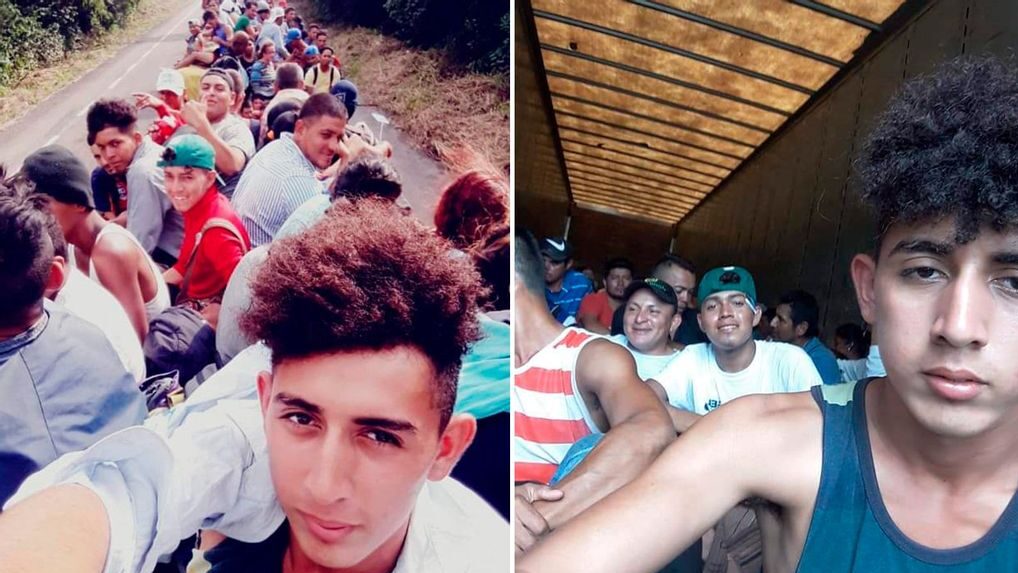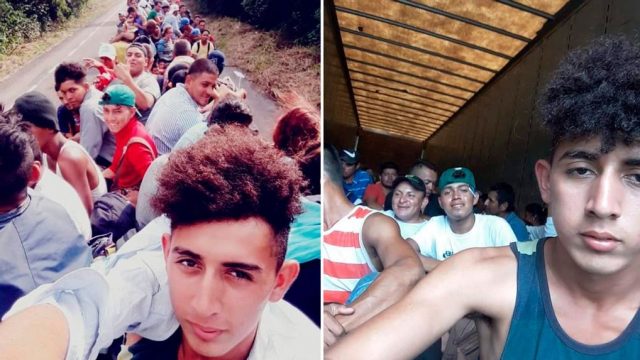
By Julio Guzmán
Migrants’ journeys to the United States are fraught with danger.
Central American migrants often experience theft, abuse of authority and extortion.
Mexico’s Human Rights Commission estimates that 42.2 percent of migrants crossing the country are victims of robbery, followed by kidnappings (10.7 percent) and organized crime (10.2 percent).
Despite the risks, Fernando Hernández, then a 20-year-old high school graduate, wanted to secure the American dream. Along the way, he changed his mind.
He used to live in Santa Bárbara, a town located about 124 miles from Tegucigalpa, Honduras’ capital. Insecurity and unemployment forced him out of his hometown.
Hernández and three friends left Santa Bárbara in a bus on Oct. 15, 2018, intending to join a migrant caravan heading to Guatemala. Hernández left his town with 500 lempiras ($23), which he spent on the bus.
Crossing the Honduras–Guatemala border, they spotted the caravan, which was adding passengers daily. They joined the group, and Hernández called his family, since he was the only one of the four friends carrying a cell phone.
The journey was not easy. He woke up every day at 5 a.m. to walk with his fellow migrants. “We rested 15 minutes per hour to be able to walk the whole day. Sometimes a truck would stop and give us a ride,” he told Zenger.
When the caravan crossed Mexico’s southern border, agents from the country’s federal police and the National Migration Institute were waiting for them at the Rodolfo Robles border bridge. But there were so many migrants crossing that Hernández and his friends managed to continue their trip.
During his journey, two caravan members died, one in Córdoba, Veracruz, and the other in the state of Puebla.
“We hung ourselves from a double trailer. The truck hit a bump, and a fellow migrant who was not holding on well fell. When the second trailer ran over him, the truck stopped. He died instantly. … It could have been a friend, someone traveling next to me, or it could have been me,” he said.
In Mexico City, the caravan rested at a temporary shelter that provided migrants with food. An estimated 5,500 people from different countries, primarily Hondurans, made up the caravan, according to a government census.

At that point, one of his friends was homesick and concerned for his family. So he boarded one of the buses bound for Honduras provided by the mayor’s office.
Hernández’s caravan left for Querétaro, where the state government provided buses that drove the migrants to Mexicali, Baja California, on the U.S. border.
Some Mexicans helped Hernández and his friends. The aid usually ranged from a coin to a piece of bread. Even so, Hernández says they slept on the streets, went hungry for several days, and traveled crammed inside trailer containers.
“Once, we were sleeping on the sidewalk, and it started to rain. We woke up and looked for a dry place to sleep. I was not feeling well, and I said to myself, ‘I think this is as far as I’ll make it.’ I wanted to quit, but then I thought about my future,” he said.
Twenty days and 2,300 miles later, the caravan reached Mexicali. One of Hernández’s friends tried to cross to the U.S. but got arrested and was deported to Honduras.
After Hernández and the last friend still with him appeared on a local TV show, an employer invited them to work in construction. However, the friend, missing his wife and children, returned to his homeland a month later.
A work project allowed Hernández to move to Monterrey, in the Mexican border state of Nuevo León, in 2019. The immigration policies that then-President Donald J. Trump put in place, including the increase in deportations, had lengthened his stay in Mexico.
In Monterrey, he rented a house with some roommates. “I slept on the floor for two months. But I saved some money, bought a bed, and rented a room on my own. I was already getting to know the city,” he said.
He was working for a cable television company in Monterrey when he met a Mexican woman. They fell in love and moved in together. One day, after work, “I went home and learned I was going to become a dad. A Honduran [baby] was on the way. She was three and a half months pregnant, and I was the happiest person in the world,” he said.

That was a turning point for Hernández. He reflected on his life perspectives and chose to live his dream in Mexico. He married his partner in August 2021, and today, they both work to provide a better future for their son.
“Now that we have the baby, I don’t want to go. I’m not going to leave him. I want what’s best for him. He needs to have a mom and a dad, a family. … Of course, I plan to go one day [to the United States], but I will … get a tourist visa.”
He also hopes to adjust his immigration status in Mexico.
Hernández’s friends feel inspired when seeing him achieve his dreams far from his homeland. Gibson Estanley Rodríguez, who left Honduras with him, also wanted to reach the United States. Along the way, he learned to value other things.
“Reaching the United States seems to be the goal, but … what we truly seek is financial stability, emotional stability, and Fernando was able to achieve all that. I’m happy for my friend, and I know that he will meet new friends,” he told Zenger.
Not all migrants are as fortunate.
Many lose their lives on the journey north. Hernández’s family is grateful he is still alive to pursue his dreams. More than three years after his departure, they all hope to see him again.
“Fernando is the youngest sibling. He taught me to be courageous and to take decisions aimed at obtaining a better quality of life. I learned we must make sacrifices if we want to achieve our dreams and that dreams are possible. Fernando and we — the family — are in constant communication, and we look forward to seeing him again,” Jerar Hernández, Fernando’s brother, told Zenger.
Hernández does not forget the challenging path he endured. Whenever he can, he supports migrants on their journeys.
He believes the essential thing migrants do is “overcoming, not giving up, believing in themselves, that they can and do achieve things. Other people’s opinions don’t matter. Back there [in my homeland], I had nothing. And I said: ‘I’m going to get through this.’ Throughout the journey, I felt bad for my family. My mother and my grandparents cried, asking me to come back. I felt pretty bad, but I didn’t give up.”
Translated by Gabriela Alejandra Olmos, Edited by Gabriela Alejandra Olmos and Fern Siegel
The post Central American Migrant Trades American Dream For Mexican Dream appeared first on Zenger News.




